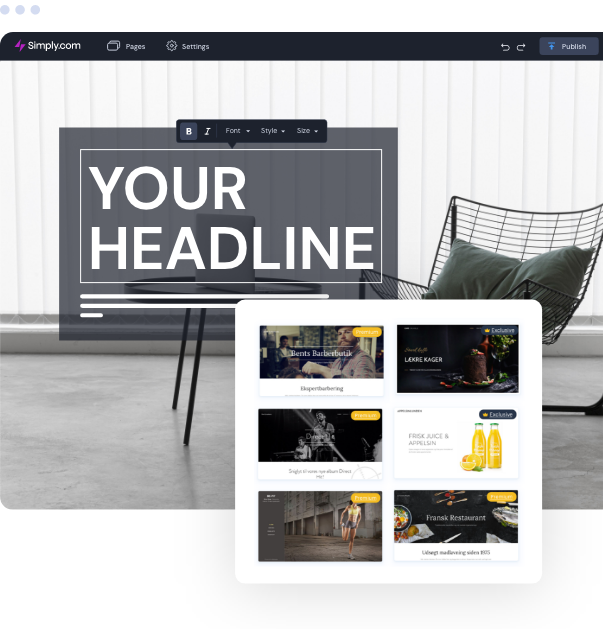Just How to Select the Right Site Design for Your Business
Picking a proper web site style for your service is a diverse process that requires mindful factor to consider of different aspects. Focusing on customer experience and receptive style can enhance accessibility and satisfaction.
Specify Your Service Goals

As an example, if your key goal is to improve ecommerce sales, focus on developing a smooth shopping experience with instinctive navigating, popular call-to-action switches, and enhanced product pages. If your objective is to establish idea leadership in your market, prioritize insightful material, involving visuals, and easy to use interfaces that motivate communication and sharing.
Moreover, integrating measurable vital performance indications (KPIs) related to your goals will certainly help assess the web site's effectiveness gradually. On a regular basis revisiting and changing these goals can make sure that your website progresses in placement with your company purposes - website design in singapore. Finally, a clear understanding of your company objectives is essential for crafting a web site style that not just meets individual assumptions yet also drives concrete results for your company
Understand Your Target Target Market
Comprehending your target audience is critical for creating an efficient web site layout that reverberates with users. An extensive understanding of your audience allows you to customize your site's visual appeals, performance, and content to satisfy their particular requirements and preferences. Begin by recognizing group variables such as age, sex, area, and revenue degree, which can significantly influence user behavior and assumptions.
Next, dive into psychographics, checking out individuals' rate of interests, values, and on the internet practices. This info helps in crafting a more tailored experience, making certain that your internet site involves site visitors in a significant method. Conduct surveys, meetings, or focus groups to gather straight responses, which can supply important insights into what your target market likes.
Furthermore, evaluate competitor internet sites that provide to a comparable audience; their successes and failings can light up finest practices and locations to distinguish your brand. Make use of analytics devices to track user actions on your present site, identifying fads that expose what captures focus and what fails to involve. By completely understanding your target market, you can produce a site layout that not only attracts site visitors but additionally promotes engagement and drives conversions.
Prioritize Customer Experience
Individual experience (UX) acts as the backbone of a reliable web site design, directly affecting exactly how site visitors communicate with your web content and navigate your website. A seamless UX can significantly improve customer fulfillment, encouraging longer brows through and raised interaction. To focus on UX, start by making sure intuitive navigation. Menus needs to be organized rationally, allowing individuals to locate information swiftly and easily.
Furthermore, think about the visual hierarchy of your pages. Crucial info should be prominently presented, leading customers towards crucial actions such as purchasing or signing up for an e-newsletter. Efficient usage of white area can also reduce cognitive lots, making it less complicated for customers to process information.
Moreover, web page lots times are important; a slow-loading website can annoy users and bring about high bounce prices. Optimize images and simplify code to improve performance. User comments is invaluable. On a regular basis get and evaluate input from site visitors to determine discomfort factors and areas for renovation. By constantly prioritizing user experience, you produce a site that not only fulfills the requirements of your audience however also cultivates loyalty and advertises business development. Executing these approaches will aid ensure your internet site is both practical and enticing to users.
Pick Responsive Layout
In today's digital landscape, selecting a receptive layout is important for ensuring your web site executes ideally throughout a variety of devices and display dimensions. As even more customers access the internet through mobile phones, tablet computers, and other gadgets, a receptive layout permits your internet site to adapt perfectly to different resolutions and positionings. This versatility improves individual experience, which is critical for keeping visitors and decreasing bounce rates.
Responsive design employs fluid grids, flexible images, and media queries to create a natural look that keeps capability, despite tool. This strategy not just enhances functionality however likewise positively influences internet search engine positions, as internet search engine like Google prefer mobile-friendly websites.
Furthermore, a responsive website eliminates the demand for preserving separate desktop computer and mobile variations, enhancing your advancement and maintenance initiatives. This performance can cause cost savings and an extra constant customer experience throughout systems.
Integrate Branding Elements
Including branding components into your website layout is vital for establishing a strong identification and cultivating recognition among your target market. Your brand's logo design, color scheme, typography, and imagery should flawlessly integrate right into the general design to develop a constant aesthetic experience. This consistency not only enhances your brand's identification yet also constructs trust fund with site visitors.
Begin by prominently displaying your logo on the homepage, ensuring it is clickable to redirect users to the primary page. Pick a color system that aligns with your brand's important site individuality; for example, vibrant colors might convey power, while muted tones can suggest refinement. Typography ought to mirror your brand name's character-- pick font styles that are both understandable and agent of your message.

Verdict
Selecting the proper internet site design necessitates a critical method that balances organization objectives with individual experience. By specifying clear objectives, understanding the target audience, prioritizing instinctive navigating, opting for responsive style, and including natural branding components, companies can improve their on the internet dig this visibility. Continual assessment and adaptation based on customer feedback and performance metrics even more make sure that the internet site continues to be reliable and pertinent. Ultimately, a well-designed website functions as an important tool for attaining company success and cultivating consumer involvement.